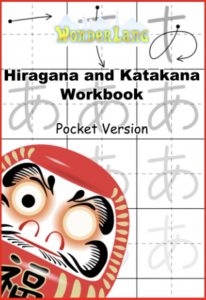Hello!
This article will give you further insight regarding how hiragana and katakana are used in Japanese. You will see: long vowels, doubled consonants and the notion of okurigana.
| Amazon.com |  |
Amazon.ca |
Long vowels
The vowels in the basic hiragana and katakana syllables are short vowels. Yet long vowels are really often present in Japanese and are represented in two different manners in hiragana and katakana.
In hiragana, the way a long sounding vowel is represented will depend on which vowel is terminating the syllable:
| Syllable ending | Long vowel | Example |
| ・あ | ・ああ | おばあさん [oba~san] – grand mother |
| ・い | ・いい | おじいさん [oji~san] – grand father |
| ・う | ・うう | ぎゅうにゅう [gyu~nyu~] – milk |
| ・え | ・ええ, ・えい | おねえさん [one~san] – elder sister えいご [e~go] – English language |
| ・お | ・おう, ・おお | とうきょう [to~kyo~] – Tokyo おおきい [o~kii] – tall |
For katakana, the representation is much simpler as we systematically use the chōonpu “ー” to represent a long sounding vowel.
| Syllable ending | Long vowel | Example |
| ・ア | ・アー | バー [BA~] – bar |
| ・イ | ・イー | ヒーロー [HI~RO~] – hero |
| ・ウ | ・ウー | サタデー・ナイト・フィーバー [SATADE~ NAITO FI~BA~] – Saturday night fever |
| ・エ | ・エー | ディー・エヌ・エー [DI~ ENU E~] – DNA |
| ・オ | ・オー | コーヒー [KO~HI~] – coffee |
Identifying and pronouncing the short and long vowels is important as some Japanese words sound similarly if we take the length of the vowel apart.
For instance おばさん and おばあさん mean respectively / aunt, mid aged woman / and / grandmother, old woman /. おばさん can be used to refer to an unknown person you are talking to if you don’t know her name, but beware the length of the あ in ば as using おばあさん to refer to a woman that is in her twenties/thirties/fourties can be taken as an insult and make that person really angry (and the same goes for おじさん / oncle, mid aged man / which can be used to refer to adult men, and おじいさん / grand father, old man /).
Doubled consonants
It is also quite common to find some words in Japanese where some consonants are doubled. This double consonant is achieved most of the time by having a sokuon (っ – a small sized つ – or ッ – a small sized ツ) standing before the doubled consonant.
けっこん [kekkon] – Marriage
「いいですよ。」って。 [“ii desu yo” tte.] – “It’s OK!” he said. (tte indicates a quotation)
こっち [kocchi] – This way.
いっしょ [isshou] – together
ロボット [ROBOTTO] – Robot
The only exception is the doubling of n syllables which is done by using the ん character:
みんな [minna] – everybody
Okurigana
Okurigana refers to the use of hiragana to complete words written in kanji like conjugated verbs, ajectives…
食べます [tabemasu] – I/you/he/she/they eat.
高い [takai] – high, expansive
Here it is for this article. Do not hesitate if you have any comment or question.
Stéphane
Follow us: